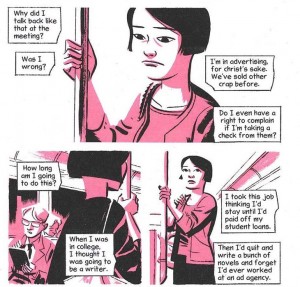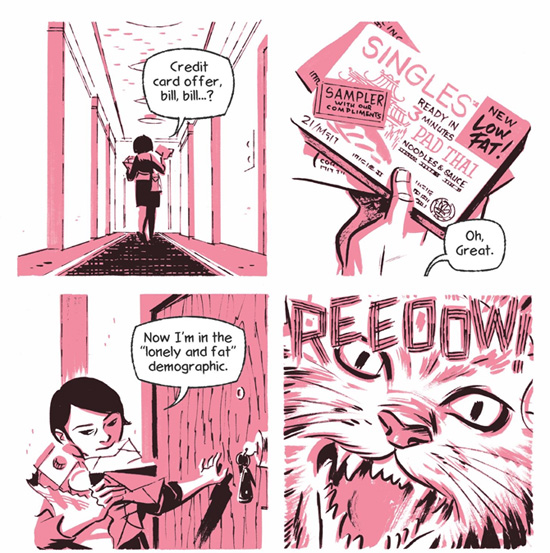SHOPLIFTER
by Michael Cho
Pantheon, 96 pages
In a recent interview, Michael Cho claimed that his crisp illustrative style developed from reading adventure comic strips from the 1930s and the 1940s. While one sees something of Noel Sickles’s thick shadows fringing his subjects and Roy Crane’s tidy closeup panels in Cho’s work (superbly featured in Back Alleys and Urban Landscapes, a gritty collection of still life illustrations), there remains a fundamental quality missing in Shoplifter: namely, the resounding thump of a human heart.
 This graphic novel tells the story of Corrina Park, a young woman who works in an advertising agency. There is nothing interesting or unusual about her, unless you believe the occasional pilfering of a magazine from a convenience store to be jaw-dropping criminal mayhem. She complains about an unfulfilled creative life. She spends her evenings in a spacious apartment guzzling down wine and watching television. She listens to her boss quote Khalil Gibran while he steeples his fingers in the hackneyed manner of a corporate stooge smuggled from behind the arras at the last minute. While I was very fond of Corrina’s hissing cat (and what does it say that the only real character with any personality in this dull and pandering volume is an animal?), I could not find any open nook in my warm and expansive heart for this extraordinary listless protagonist. Corrina is no different from millions of young bourgie aspirants whinging throughout North America. If I wanted this kind of vanilla and unadventurous narrative, I’d spend two insufferable hours being barraged by other people’s First World problems at the Whole Foods overlooking the Gowanus Canal.
This graphic novel tells the story of Corrina Park, a young woman who works in an advertising agency. There is nothing interesting or unusual about her, unless you believe the occasional pilfering of a magazine from a convenience store to be jaw-dropping criminal mayhem. She complains about an unfulfilled creative life. She spends her evenings in a spacious apartment guzzling down wine and watching television. She listens to her boss quote Khalil Gibran while he steeples his fingers in the hackneyed manner of a corporate stooge smuggled from behind the arras at the last minute. While I was very fond of Corrina’s hissing cat (and what does it say that the only real character with any personality in this dull and pandering volume is an animal?), I could not find any open nook in my warm and expansive heart for this extraordinary listless protagonist. Corrina is no different from millions of young bourgie aspirants whinging throughout North America. If I wanted this kind of vanilla and unadventurous narrative, I’d spend two insufferable hours being barraged by other people’s First World problems at the Whole Foods overlooking the Gowanus Canal.
Cho certainly has the chops to transpose his observations onto the page. A hip bestubbled specimen named Ben offers a perfectly complacent and beery look when he says, “Yeah, you too, Corrina,” at a party. When Cho populates his frames with strangers, especially on subways and at the party, there is a feral yet controlled quality to his illustrations. I also appreciated the deliberately cramped framing at the convenience store, almost as if we are witnessing the action through an impossibly placed surveillance camera. But it’s maddening that his characters lack the dimension to match the artwork.
Michael Cho is a man who does not court danger in any way. Even Shoplifter‘s denouement plays out like a didactic game of Whac-A-Mole, with its shopworn trope of a shopkeeper with a heart of gold. Yet at least one middlebrow hack wheezing in Los Angeles has risibly suggested that Cho is “operating out of a tradition,” without remembering the degree to which 20th century artists were persecuted for their “unwholesome” tales. As astutely documented in David Hajdu’s The Ten-Cent Plague, comic book artists faced professional and criminal punishment, as well as charges of contributing to “juvenile delinquency,” simply because they had the effrontery to tell visual stories that were odd or weirdly imaginative. It’s bad enough that the contemporary fiction market has become saturated with mediocre narratives of privileged people blogging or vacationing in Europe, but do we have to flood the comics market with this gutless junk as well?
Now that comics have become widely accepted, with unscrupulous sharks in suits sauntering through San Diego’s relentless cacophony to snatch up any young pup who can make them a few easy bucks, I’m wondering why someone as talented as Michael Cho has willfully ignored the fiercer tradition that made comics fun in the first place.
